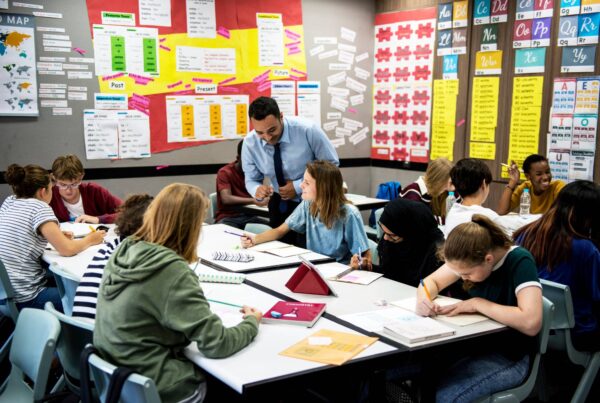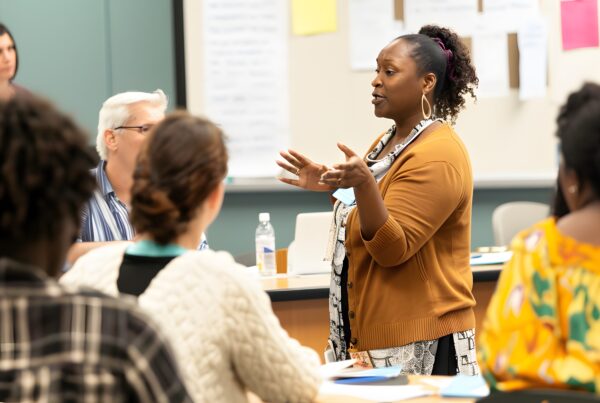“Although research clearly identifies teacher skill as one of the most, if not the most, important factors in driving student achievement…many evaluation models lack the specific, growth-oriented feedback teachers need to improve instructional practice, and few teacher evaluation models are designed to produce measurable gains in teacher performance” (Marzano & Toth, 2013, p. 4).
In our overview article for the five conditions for teacher expertise, we encouraged you to reflect on your school’s current practices related to growth and professional development. Using a decision-making process, you prioritized the five critical conditions (see Table 1) to determine where to focus going forward. We explored specific ideas and strategies for building the first of the five conditions: Common Language of Instruction. The next step is to focus on the second critical condition: Encouraging teachers in deliberate practice and providing specific feedback to foster growth.
Is the purpose of a teacher evaluation model simply to measure teacher expertise, or is the purpose of that model to improve teacher expertise? Instead of seeing teacher evaluation as something to check off the to-do list each year, you can implement a model that allows teachers to learn and grow professionally with measurable results.
| Five Critical Conditions for Increasing Teacher Expertise |
|
Table 1. Marzano, Frontier, and Livingston (2011, p. 4)
What is deliberate practice?
Deliberate practice can be defined as a focused loop of intense practice on specific skills, followed by targeted feedback and further practice. Deliberate practice is an effective developmental strategy to help turn low-performing teachers into effective teachers and to help turn effective teachers into highly effective teachers.
Significant research has shown that deliberate practice is a proven pathway for any person in any discipline to improve virtually any skill (Ericsson et al., 1993).
Athletic coaches have long embraced deliberate practice. For example, a basketball coach who is teaching young students to dribble the ball doesn’t just say, “Go dribble it.” Rather, he or she teaches the skill, then watches students try it, helps individual students identify what they could do to improve, then sends them off to practice that discrete piece of the skill, continuing to give feedback and adjust along the way.
Among Anders Ericsson’s (2006) findings is that the level of expertise one achieves has more to do with how one practices than merely how many times one practices. Deliberate practice refers to a special type of practice that is purposeful and systematic. While regular practice might include mindless repetitions, deliberate practice requires focused attention and is conducted with the specific goal of improving performance.
Deliberate practice always follows the same pattern: break the overall process down into parts, identify your weaknesses, test new strategies for each section, and then integrate your learning into the overall process.
| Focused Feedback and Deliberate Practice: How will you know when this attribute is strong in your school? |
|
What are the benefits of building teacher capacity through deliberate practice and effective feedback?
- Teacher autonomy: When teacher evaluation is used in a system of feedback and deliberate practice, it encourages teacher autonomy by giving classroom educators a powerful voice in directing their own growth.
- Skill mastery: Mastery is facilitated with a robust collection of research-based teaching strategies to span an entire career of continuous improvement.
- Purpose: Focusing on building teacher capacity to increase student achievement creates a sense of purpose and meaning (Marzano & Toth, 2013).
- Professional collaboration: Teachers and administrators become partners to improve pedagogical skills.
- Empowerment: Teachers are empowered to take responsibility for their own professional growth and development and become agents of their own expertise.
- Expertise: As teachers increase their effectiveness with specific, discrete target strategies, it tends to lift their overall teaching.
- School culture: The culture of the school is positively impacted as teachers collaborate to grow instructionally.
- Student achievement: As teachers grow their own capacity through deliberate practice and feedback, students ultimately benefit through improved pedagogy which boosts academic achievement.
6-step plan to build a culture that supports feedback and deliberate practice
How will you introduce deliberate practice to your teachers, get buy-in, and communicate the benefits of implementing deliberate practice? The following 6 steps can help you build a culture of continuous improvement in your school or district.
| 1. Set the vision and expectations: Every teacher — from veterans to fresh from college — can grow their professional skills and improve student performance. As a leader, your job is to intentionally build a culture that supports professional learning, sharing, collaboration, and feedback. Maintaining this culture requires a strong plan, transparency, and ongoing communication.
Suggestion: Communicate a clear set of steps that teachers can count on. Let teachers know they will be supported by experienced coaches, peers, or mentors. Inspire teachers by sharing the benefits of leading their own deliberate practice plans in partnership with you and other evaluators. |
|
| 2. Self-assess: Focus on specific strategies from the instructional model () and ask teachers to reflect on their instructional techniques to identify “thin slices” of teaching behaviors for personal focus and deliberate practice. Example: A golfer wants to be more successful on the course. His or her first step is to identify what is working well and what can be improved. Honest self-assessment is the key, which often entails having others provide insight from observation.
Suggestion: Systematize a process for self-assessment so it becomes part of the building culture. MEC’s iEC’sion tool provides tools to support this process in the Marzano instructional model. Teachers can use these or other tools to self-assess and create their growth plan, including goals and action steps. |
|
| 3. Create growth goals: Partner with the teacher to identify key areas for learning and to craft specific and measurable goals that are “focused” on a slice of instruction (too broad will not work, too narrow will not work). Example: The golfer can improve his or her golf game by focusing on specific thin slices or aspects of the game – like improving the swing (strategy) and then breaking that down even farther to grip, stance, follow-through.
Suggestion: Encourage collaboration with coaches and peers as teachers develop their goals to ensure they are SMART (specific, measurable, attainable, results-based, time-framed). Review goals with teachers to set them up for success. Having goals that are too broad, too complicated, for which there is no way to measure accomplishment only serves to frustrate teachers and administrators and leads to less investment in what should be an ongoing process. |
|
| 4. Develop action steps: Help teachers identify specific learning and practice opportunities to build expertise in these areas. Example: In the golf analogy, when the player has identified the next area for growth, he or she seeks coaching or watches videos, reads articles, and practices the swing with the new knowledge and understanding.
Suggestion: Provide job-embedded professional development and other resources that support teachers in reaching their individual goals for each element (thin slice) that not only describe but give many examples. These protocols can be used to give teachers dedicated time to explore ideas from which to draw. Often, PLC groups or content teams will collaborate on growth goals and action steps. They may offer to serve as partners, observing each other and providing feedback. For instance, all teachers who chose Identifying Critical Content can be organized into a group, using Discussion Groups in IE’s Observation tool or by having them meet in person to support each other, provide ideas, and share progress. |
|
| 5. Reflect: Plan and intentionally provide specific feedback that validates incremental growth within collegial coaching/mentoring conversations. Example: When the player implements the golf swing, he or she seeks feedback, both from results (did the ball fly straighter and/or farther, etc.) and from observers, coaches, friends. Then, the player either fine-tunes that same new strategy to get even better results or identifies another key part of the game for a new focus.
Suggestion: As Dr. Stephen Covey said, “Seek first to understand, then to be understood” (2016, p. 215). Any counselor will attest that the power of reflective conferences lies in guiding the subject to his or her own conclusions. Answers that are given have not nearly the power of answers that are discovered. Encourage teachers to reflect and demonstrate understanding of what worked and didn’t work when implementing their targeted strategy. When providing feedback, ensure that it is concrete, specific, and useful. If the observer says, “You need to be more creative,” what does that mean? Be more creative in what way? How can a teacher learn and grow from that feedback? Provide evidence of what prompts the suggestion and ideas for next steps. For instance: Ms. Lee, I noticed you used engagement strategies such as managing response rates, physical movement, and a lively pace to engage your students with the result that 18/24 students were engaged with the content. Based on this student evidence, what adaptations might you make so that more than 90% of your students (22/24) are engaged with the content? |
|
| 6. Track and celebrate progress: Develop positive mentoring relationships with teachers. Assist teachers to track their progress in developing expertise through ongoing classroom observations and assessing the effectiveness of their plan. Example: The golfer has immediate feedback known as a score. They can measure the overall effectiveness of their practice through that, and through specific improvement in the discrete skills on which they focused.
Suggestion: If it becomes apparent that the initial measurement strategy is ineffective for the purpose, ensure that new measurement strategies are identified. Meet with the teacher at least once during the year to assess progress on the plan and make any needed adjustments. Again, the goal is to maximize teacher success, not to catch them doing something wrong. If the action steps have proven unwieldy, or if the teacher needs a partner or coach, catching it sooner rather than later is the key. IE’s Observation tool provides easily accessed reports that allow teachers and administrators to track their progress towards their growth goals. |
What can leaders do?
Most teachers have the desire to improve – and all have the ability. Similarly, all students can learn. Deliberate practice, with its critical components of intense focus on specific skills, expert feedback, and teacher-driven cycles of continuous improvement, has been shown to be the most effective pathway to developing expertise.
- Involve teachers in the development of a deliberate practice plan.
- Communicate the plan to all teachers, both verbally and in writing.
- Set teachers up for success by providing significant support as teachers first begin to build their deliberate practice growth plans.
- Ensure coaches, mentor teachers, PLCs and others have access to resources that support teachers’ growth.
- Follow up at designated times during the year to celebrate progress, assist a teacher to adjust or adapt his or her plan, and to identify any additional needed resources.
References
Covey, S. R. (2016). The 7 habits of highly effective people: Powerful lessons in personal change. Free Press.
Ericsson, K. A., Krampe, R. T., & Tesch-Romer, C. (1993). The role of deliberate practice in the acquisition of expert performance. Psychological Review, 100(3), 363-406.
Ericsson, K. A. (2006). The influence of experience and deliberate practice on the development of superior expert performance. In K.A. Ericsson & N. Charness et al. (Eds.), The Cambridge Handbook of Expertise and Expert Performance (pp. 685-706).
Marzano, R. J., Frontier, T., & Livingston, D. (2011). Effective supervision: Supporting the art and science of teaching. ASCD.
Marzano, R. J. & Toth, M. D. (2013). Deliberate practice for deliberate growth: Teacher evaluation systems for continuous instructional improvement. Instructional Empowerment.
About The Author: Kathleen Marx
Kathleen Marx, MSEd, is a leading expert in personal development across industries. Ms. Marx has worked closely with Dr. Robert J. Marzano and the Instructional Empowerment team in developing content and training new staff developers. Her background in classroom teaching, gifted education consulting, school counseling, life-success facilitation, and school leadership give her unique insights into leading strategies in implementing research-based instructional and evaluation models. She earned her master’s degrees in educational leadership and school counseling from the University of Dayton.





